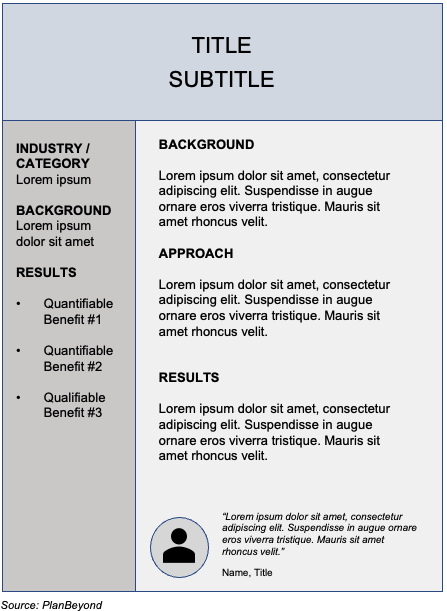Ready to create case studies? If you’re a B2B business (or a B2C business with long sales cycles), you should be. Case studies fuel a host of marketing and sales activities, from PR and content marketing to outbound sales enablement.
But, volume matters. The more case studies you have that represent a wide variety of industries, use cases, and benefits, the more you can pick the right story for the right context.
Thankfully, you can scale case study creation with classic market research approaches. Because case studies are, at their core, tailored one-to-one interviews, you can templatize the approach and create a case study arsenal in as little as 2-3 months.
Why Create Case Studies
Creating case studies takes time. We won’t dispute that! But, the benefits of creating case studies is so great that it’s well worth it. Check out some of the benefits most organizations derive from building up their arsenal:
PR Opportunities
After a business launches a new product or service, there isn’t much “newness” to announce. This means you have to make news. Finding great customer wins gives PR teams something worthwhile to pitch. These stories talk to the business’ products or services in an intersting, not too business-centric way, offering great PR fodder.
Marketing Nurture Activities
In longer sales cycle businesses, you need to keep you product top of mind. Using case studies throughout your nurturing and bottom-of-funnel outreach activities gives you targeted content to do just that.
Top-Of-Funnel Marketing Activities
Most companies need to fuel their social media, blog, and email marketing activities to attract new attention. Slicing and dicing case studies into smaller content pieces lets a marketing team produce top-of-funnel content for months on end.
Outbound Sales Materials
For those businesses doing outbound sales, case studies serve as valuable entry tools. Citing a customer name and the the business benefits they enjoyed builds credibility and gives an outbound sales team the chance to pitch a prospect on a meeting or demo.
In sum, when you create case studies, you create a content marketing and sales activation engine.
Start With The Case Study Output Template
Using market research to create case study libraries means developing a scaleable approach. That’s why we always say start from the end and then work backwards. When it comes to case studies, that means start with your final template or output layout. Once you know what you want your output to look like, you’ll know what information you’ll need to fill it in.

As you can imagine, there are a lot of ways to build out your case study template. Nevertheless, the example on the left is a standard approach we like. This is because it includes a few key components:
- Skimmable Text: Most prospective customers are in a hurry. This means they may not want to read a full story. Having a column or area that makes it easy to glean the case study content solves this problem. With a bulleted text and results area, readers absorb the story quickly. From there, they can read the fuller story or move on.
- Long-Form Story: For prospects that want the entire story, include the main body area. This is paragraph-based text that offers a synopsis of the customer’s background, how they approached their problem using the solution, and the tangible benefits received.
- Individual Quote: Social proof matters. There are few things more impactful than a person willing to give their name and likeness to another company for marketing purposes. That’s why, if possible, include a customer quote.
Design Your Case Study Questions
Obviously, the questions you ask will depend on the nature of what your product or service does. You’ll need some amount of question tailoring. That said, if we look at our template above, you’ll see you need to ask questions around three key areas:
Business Background
These are questions that isolate the business challenges a customer had, and what led them to look for your solution in the first place. Typical questions include:
- • Tell me a little about your organization (e.g. employee number/background, what people are tasked with, core KPIs, etc.)
- • What challenges did you have that ultimately led you to seek out a solution?
- • Why were these issues so problematic?
- • What was your go-to approach to addresses this before you starting using our product?
Approach
This is where you marry the customer’s problem with your solution. These questions let you illustrate how people use your solution to address a variety of needs. Some sample questions include:
- • What was it about our product that led you to pick it?
- • How did you first go about using it?
- • Were there certain features in particular you / your team found critical? If so, which ones and why?
- • What was especially beneficial / useful about the experience?
Benefits
Especially important are tangible, quantifiable benefits that let you tout really clear product wins. Some questions we often use include:
- • Tell us about [time savings, cost savings, faster resolution times, faster throughput times, etc.] you got from using the product. How did that come about?
- • Thinking about broader business goals, how did this fit in? How did the product help you meet those objectives?
- • Were there any unexpected benefits you received from using the product?
Structure Your Outreach & Production Workflow
Once you finalize your questions, you’re ready to gather up your case study interviews. This means developing a process for reaching out to customers, gathering their stories, and formalizing the stories into complete case studies.
The typical workflow includes the following approach:
1. Develop An Outreach List: First, build a list of all the customers you hope will give you a story. This usually means working with sales or customer service reps to build out an initial list. As they enter in names, also ask them to include a “Why.” That is, what do they know about this customer that makes them a great case study opportunity.
2. Perform Outreach: With your list finalized, it’s time to reach out and request a case study interview. We suggest developing email templates and phone scripts for your sales and customer service teams. This lets them spend their time on outreach, not on figuring out how to ask for the interviews in the first place.
Include an explanation of what the process is, why you’re doing it, and what they may get in return. This is also where you mention any incentive you wish to offer.
3. Schedule The Interviews: Once a customer says “yes,” get them scheduled! You can do this manually or with a tool. For example, we like using Calendly, a scheduling tool that lets you streamline scheduling and get meetings faster.
4. Complete The Interviews: This is the part where you get to use your interview questions with each and every customer. It’s also where you can go a bit off script. As you listen to answers, don’t be afraid to probe for more details. Each story is a little different, and therefore may require some tailored questions.
5. Draft The Story & Get Approval: With the full story recorded, clean it up and draft it into your standardized case study template. Because you are likely using customer names, you’ll need to share the document and get their approval. Or, get their feedback and make necessary edits.
6. Finalize Design & Publishing Approach: With approval in-hand, you can finally share the story. At the simplest level, this likely means putting it into a PDF for easy shareability and pushing it live on your website. However, it should also include sharing it with your content and sales teams and letting them consider how they can leverage it for their particular needs.





